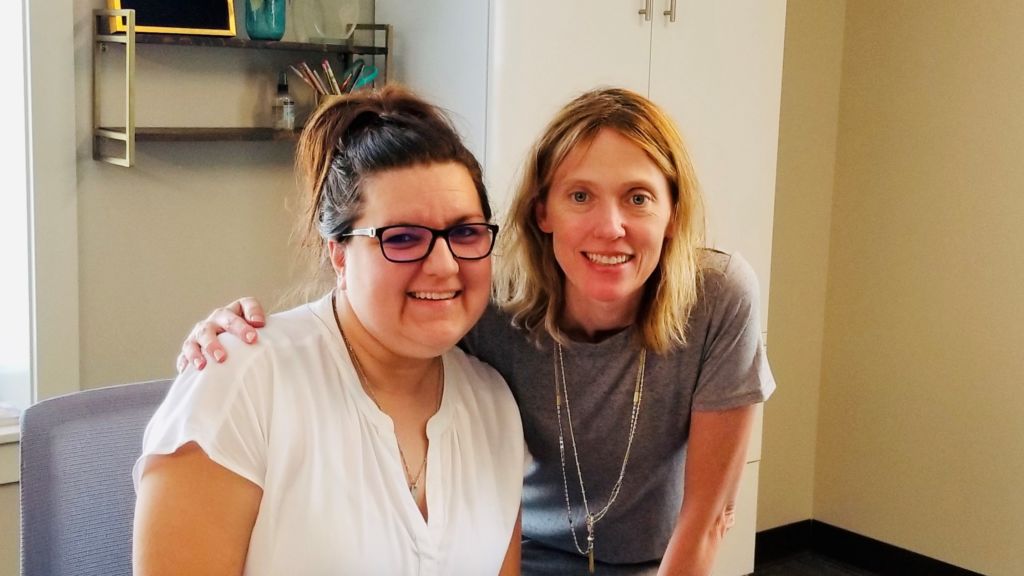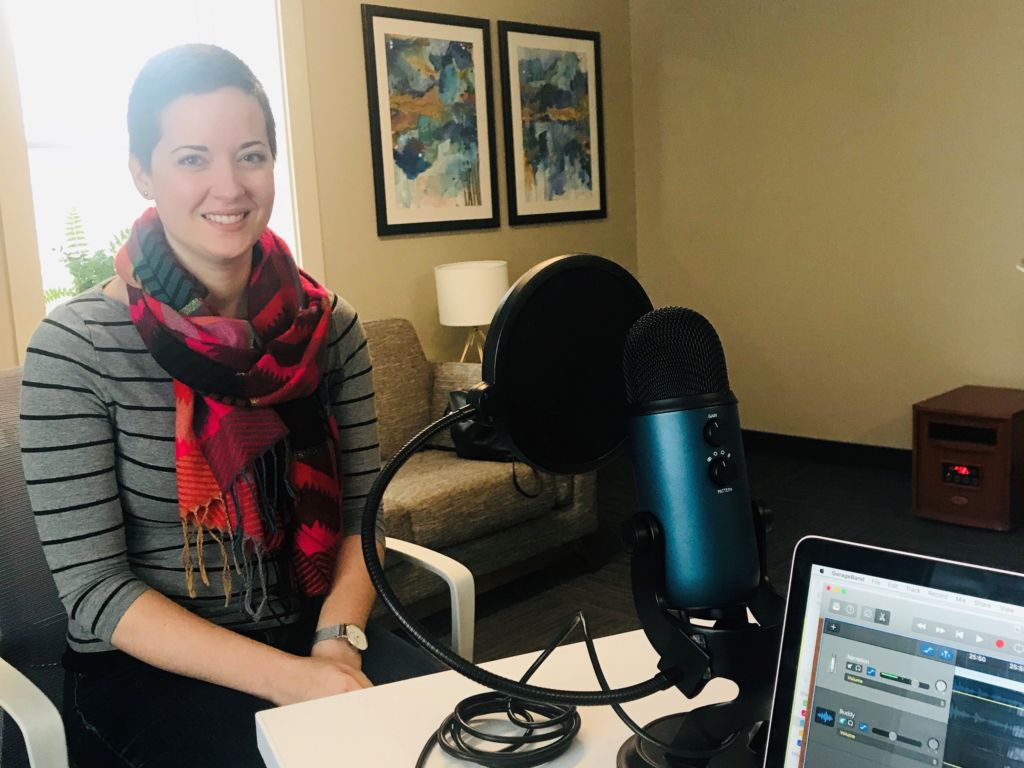Maddie’s Birth Story: Podcast Episode #83
Our listeners love hearing a positive birth story. Today Maddie, a previous HypnoBirthing and Birth client, tells us all about her labor and delivery as well as her experience in the hospital right after having her baby. You can listen to this complete podcast episode on iTunes or SoundCloud.
Kristin: Welcome to Ask the Doulas with Gold Coast Doulas. I’m Kristin, and I’m here today with my former birth client, Maddie, and we’re here to talk about her personal birth story. Welcome, Maddie!
Maddie: Thank you. I’m glad to be here!
Kristin: So we talked a little bit about why you chose HypnoBirthing in a previous podcast, so tell us about your birth story. How did you know you were in labor? Give us all the details. I was lucky to be there!
Maddie: Yes, it was wonderful to have you there! I went into work on a Wednesday, and I was due July 18th, and it was July 13th. For some reason, I just kind of thought, oh, I’ll know. It’s not going to happen yet. I went to work; I had a normally-scheduled weekly appointment with my midwife. I went at 10:30, and I had been kind of grouchy all day and just felt a little off but did not think about it at all. I’d been having practice labor for a few weeks, so I really wasn’t noticing anything different. I went to my appointment and sat down, and she said, how are you feeling? And then I started bawling. I said, “I just feel so confused by my body!” And she was like, well, let’s just take a look. How about we just take a look, and so she did an exam, and she said, girl, you’re six to seven centimeters! And I was like, what?! And I started crying again, and then I said, but what does that mean? Even though I’d been through HypnoBirthing; I knew what it meant, but it was just so unexpected. I was so far along already. She was fantastic; she was so wonderful, and she said, well, it means you’re going to have a baby today. Go have some lunch. So I called my husband. He was working, and I told him I was six to seven centimeters, and he said, well, what does that mean? And I called my mom who was coming, and she said, but wait; what does that mean? So we were all pretty taken off guard because it wasn’t like I had woken up and said, oh, you know, I think something’s happening. No one was really prepared. Hey, I’m six to seven centimeters.
Kristin: Right, I couldn’t believe it when I got the call. I was like, what?!
Maddie: Yeah! I went and got some lunch and drove myself to the hospital and parked on the fifth floor of the parking structure and waddled in. You showed up; you were the first one, and we went up to the room. Fortunately, since I’d already had the exam, I didn’t have to go through and wait for 20 minutes for them to monitor me or anything.
Kristin: That’s so nice to skip triage and go right up.
Maddie: We went up the room, and it was not bad for a really long time. You know, my body was doing a lot of the work as far as maybe turning the baby or getting more effaced. Having done HypnoBirthing, I knew that dilation is not the only factor that you need to pay attention to, so I was able to just kind of relax and say all right, it’s going to happen when it happens. You were there; you did a lot of hip squeezes for me, which was really fantastic for that counter pressure, because I was having back labor. My husband is not able to do those with his wrists, so that made a huge, huge difference. And we just kind of hung out, and I listened to my HypnoBirthing, and I listened to some relaxing music. My appointment was at 10:30, and he wasn’t born until 10:45, so it was a while, but…
Kristin: But for a first-time mom, it was pretty quick, and it’s one of the few calls I get in the daytime hours. Most of the time, I get a call at 2:00 AM or 11:00 PM.
Maddie: Right! Things started to get ramped up some, and then I started noticing it more, but none of it was overwhelming. One thing that we talked about in HypnoBirthing was breaking the amniotic sac. That’s protection for baby, so I didn’t want to do that; didn’t really feel like there was any reason to. The contractions really weren’t bad. The surges weren’t overly painful or overwhelming, and so my midwife worked her full day at the office and then came in. She checked me again quite a bit later, and then she did accidentally break the amniotic sac, and then after that, things got pretty intense.
Kristin: Yeah, that can intensify a lot!
Maddie: Yeah! I think from the time my water broke until the baby was born was about 2 hours and 45 minutes, so doable. I spent a lot of the time in the tub, and that felt really great. My husband was able to just use the hand shower, and having that, the different points of pressure, I think kind of helps take your mind off of it to some extent. The water makes it a little less intense. I really liked to be in there. Then we got out, she said she wanted to check me, and I was Group B Strep positive, so they wanted to do another round of antibiotics. That had been one thing that, when I found out, I was super devastated, because I wanted to labor at home for as long as possible. I didn’t want to have to come in before six centimeters, and we had me the plan that if I came in and I wasn’t six centimeters, I didn’t want to know what I was at. But I would just not go home. You could know; my husband could know, and then we could make the decision. Let’s walk around a little bit or just not be admitted. But because I was already six to seven centimeters, when I was checked, we went right in after I got lunch. We went right in and got admitted, so I was able to get those antibiotics in. Once she checked me again and broke my water, it got intense. It was really just — I felt very internal. You know, it was not a lot of talking, and it was — I think right after it broke, I kind of got to that point where I was like, oh, no. I can’t do this!
Kristin: Which most women go through with unmedicated births. Transition!
Maddie: Right. However, as soon as I had that thought — I have a distinct recollection of, oh, no, I can’t do this. No, wait – that means I’m really close. That means I can do this. And so then I really tried to just focus on my breathing, because we’d talked about that and learned and practiced about getting those breaths in. And I did end up struggling with that, but having you, having my husband, having my midwife all saying, all right, this is the birth you prepared for. You can do this. Just take those big breaths. Breathing and focusing on those voices helped me to kind of get back on track, get it under control. We tried a lot of positions for delivery, which that was one big thing. I had changed providers pretty early on from an OB who said you’re only allowed to birth on your back, and I said, I want the freedom to do whatever position feels comfortable for me and for my baby and my body. And so I ended up doing a lot of my laboring and pushing leaning over the back of the bed on my knees, and that definitely felt like the best position for me. We tried on the side with the peanut ball.
Kristin: I remember trying a lot of different positions, and it’s all about listening to your body.
Maddie: Right, and my body was saying, this does not feel good! Don’t do that! So I spent a lot of time there, and then I got to a point where I just remember feeling so hot and just, you know, put as many ice-cold washcloths on me as possible. I was so hot, but I was just kind of getting right there to the end. It was right at the end, and then my midwife had said, okay, I want to check you after this next surge, and so I want you to roll over. And I already knew I was crowning, but I couldn’t really explain it at that point. I’m like, no, no. He’s there.
Kristin: Right. I feel him!
Maddie: He’s right there! So I did end up flipping over, and that was okay on my back, and that was fine. What was helpful was the nurse that was there; she had said, do you want a mirror? And I had said no, no, I don’t want a mirror. And then she said to reach down and feel your baby. When I could feel — he’s right there. More than just oh, I feel it with my body, but actually touching it with your hand — he’s almost here! That kind of gives you a little reinvigoration. I’m right there at the end! So I was able to catch my baby and put him right on me and do optimal cord clamping. It was fantastic, just beautiful. He was born on July 13th at 10:45 PM, so about 12 hours from when I figured out that I was in labor until he was born. And it was being just relaxed about the whole process and recognizing it’s going to happen when it happens, and your body is going to do it, and trusting your body.
Kristin: Exactly, trusting your baby and your connection with your own body and your baby, because it’s the two of you working together along with, of course, your partner and support team.
Maddie: The very first thing I ended up saying after Charlie came out was, good job, buddy! He was a part of it, too.
Kristin: Exactly, babies work so hard! They have to turn in the canal and — yeah, they’re exhausted. You’re exhausted.
Maddie: Exactly, there’s a lot happening. It was beautiful!
Kristin: It really was. It was an honor to support you. How did it go with the skin-to-skin time and breastfeeding as a first time mom? Let’s talk about some of that and how you felt bonding in that first golden hour.
Maddie: That was fantastic that I could do skin-to-skin right away. I didn’t feel pressured to stop. That was super important. I did have some postpartum bleeding, and so while all of that was being taken care, not being separated from my baby was so big so I could just focus on him. That part was wonderful. We got all cleaned up. The breastfeeding definitely was more difficult. I have one side that’s inverted normally, and so baby really struggled to latch on that side, but he also struggled on the other side. I was fortunate that Spectrum has IBCLCs on staff 24 hours a day, and so they were able to come in at 3:00 AM and focus on what’s going on, why is baby not latching. We did end up using a nipple shield, and that was pretty demoralizing for a while. We used it until six weeks, and I went to some Le Leche League meetings and things like that. It really was important to have those contacts ahead of time and know where the meetings are; know when the meetings are; know an IBCLC that’s recommended in case you are having those issues so you’re not having to try to figure that out when you’re exhausted and you’re feeling downtrodden and things aren’t working. It’s really hard to try to find that when you’re already struggling. So having figured that out ahead of time, I was able to go to a meeting, go meet with a lactation consultant again. We did stick with it, and then at six weeks, which is pretty common, he just kind of got it. We got in the tub where it was warm and kind of womb-like and got rid of the nipple shield, and it worked.
Kristin: That’s amazing that you were so persistent and it paid off!
Maddie: Yes! We just weaned at 2 years and 11 months.
Kristin: Oh, congrats!
Maddie: Yes, that was exciting. We had a fantastic nursing journey. If you really stick with it and arm yourself with that support system, you can do it. I feel like so many women don’t have that support system. My mom nursed; my sisters nursed all of their children. Having that support system makes a huge, huge, huge difference.
Kristin: Yeah, and like you said, just taking advantage of lactation while you’re in the hospital, even for moms who have a great first latch, to just have someone see your holds and answer any questions you might have — it’s a resource that I highly recommend anyone take advantage of, if they’re birthing in the hospital, of course.
Maddie: Right. That was important that they did come in. They came multiple times to check on us and did work on holds and really understanding, you know, here’s another technique. Here’s another hold to try if this one isn’t working, so you have those skills in your toolbox to pull out. Okay, this isn’t working; let’s try this. That definitely was helpful for me, as well.
Kristin: Great! Well, thanks for sharing your story! Do you have any parting words?
Maddie: I would just say to do your research. It’s easy to just say that my doctor is going to do what’s best for me. This is what happens. This is how it goes. But it doesn’t have to be. You can be such an advocate for yourself, and you can surround yourself with other people to advocate for you so that you can get the type of birth that you want so that you have the support that you need. Even if you have a partner that’s not able to be there in the way that you need, you can get a doula. You can have a midwife who births in the hospital. It’s really not different. I know people that really think, oh, they’re not a doctor. That’s totally different. Just really doing your research and asking other moms who have been through it. Moms are very willing, good or bad, to give you their advice, so get as much information as you can so that you can make your own informed decisions.
Kristin: Yes! Thank you for sharing your story because other women want to hear personal, especially positive, stories. I feel like when it comes to birth, you here the dramatic or tragic. Everyone likes to tell negative stories, and there aren’t enough positive, and a lot of women in pregnancy want to surround themselves with light and positivity. We really appreciate you coming in! Thanks so much, Maddie. Thank you, everyone, for tuning into our podcast. Remember, these moments are golden.
Maddie’s Birth Story: Podcast Episode #83 Read More »





